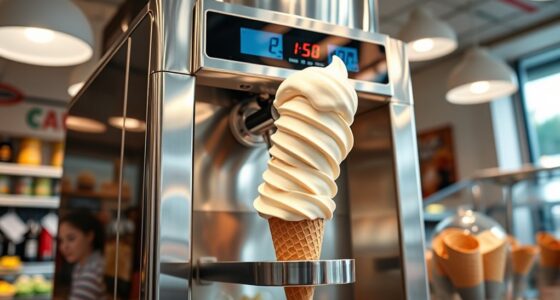If you’re confused by ice cream maker terms, understanding key parts like the compressor helps you know how it cools the mixture by compressing refrigerant to remove heat. Terms like paddle or dasher refer to the blades that churn to keep ice crystals small, while freezer bowls need pre-freezing, whereas built-in models do it automatically. Knowing these basics helps you choose the right machine, and there’s plenty more to discover if you keep exploring.
Key Takeaways
- Compressor and Refrigeration Cycle: The system that cools and freezes ice cream by circulating refrigerant through coils, acting as the machine’s engine.
- Paddle or Dasher: The rotating blade that churns the mixture to incorporate air and prevent ice crystals, ensuring a smooth texture.
- Freezer Bowl vs. Built-In Freezing: Freezer bowls require pre-freezing for flexibility, while built-in mechanisms freeze automatically for convenience.
- Manual vs. Automatic Machines: Manual models need pre-freezing and stirring, while automatic ones handle churning with minimal effort.
- Freezing and Chilling Times: Proper timing affects texture and flavor; too quick or too long can lead to icy or overly hard ice cream.
What Is a Compressor and How Does It Work?
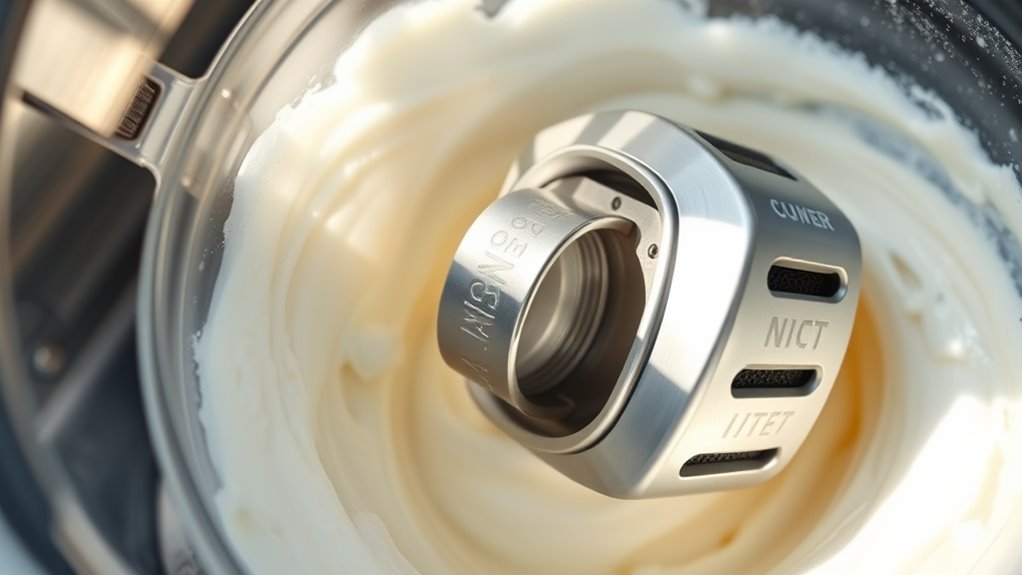
Ever wonder how an ice cream maker quickly transforms liquid ingredients into a creamy treat? The compressor plays a crucial role in this process by facilitating the refrigeration cycle. Its main function is to compress refrigerant gas, raising its pressure and temperature. As the refrigerant releases heat, it moves through coils, cooling down and becoming a liquid. This cooled refrigerant absorbs heat from the mixing bowl, lowering its temperature and freezing the ice cream mixture. The compressor then repeats this cycle continuously. Fundamentally, it acts as the engine driving the cooling process, ensuring your ice cream churns smoothly and quickly. Additionally, the compressor’s efficiency can be affected by the refrigerant properties, which are vital for optimal performance and energy consumption. Proper calibration and maintenance of the compressor are essential to maintain consistent freezing performance. The type of compressor used can also influence the noise level during operation, affecting user comfort. Without the compressor’s function within the refrigeration cycle, you wouldn’t get that perfectly frozen, creamy texture you love in homemade ice cream. Regularly inspecting and cleaning the compressor components can help prevent performance issues and ensure longevity. Recognizing how the compressor integrates with other components of the system can help troubleshoot and optimize your ice cream maker’s operation.
Manual vs. Automatic Ice Cream Makers
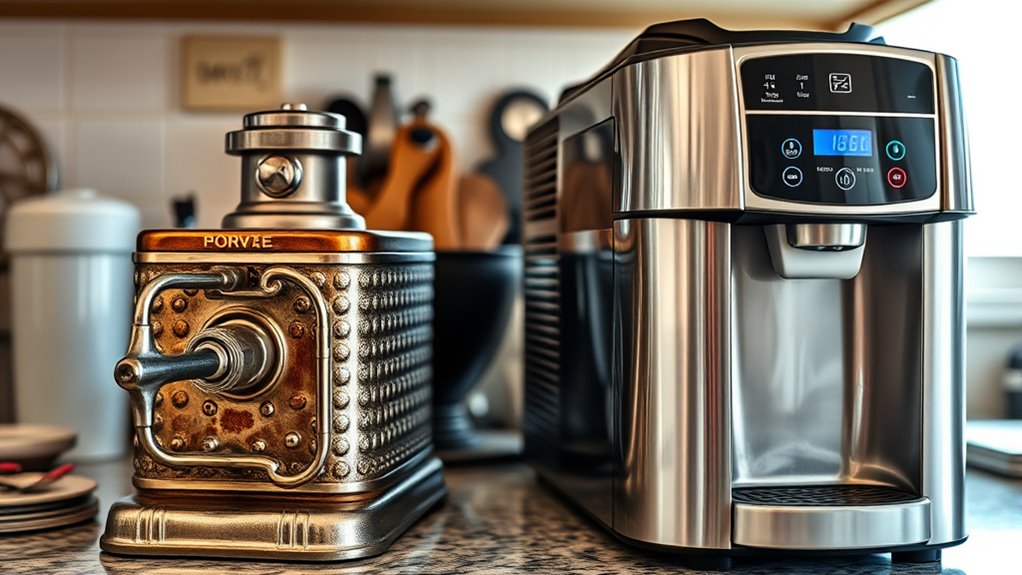
Manual and automatic ice cream makers differ primarily in how much effort you need to produce your frozen treat. Manual models require you to pre-freeze bowls and manually stir or churn, meaning more hands-on effort. Automatic machines handle the churning process with minimal input, making them more convenient. When choosing, consider safety precautions like avoiding overfilling and maintenance tips such as cleaning parts regularly to prevent mold. Here’s a quick comparison:
| Feature | Manual | Automatic |
|---|---|---|
| Effort Required | High, manual stirring | Low, machine handles churning |
| Speed | Slower, depends on user | Faster, consistent process |
| Maintenance | Regular cleaning needed | Easy, mostly self-cleaning |
| Safety Precautions | Avoid overfilling, sharp parts | Follow manufacturer instructions |
Additionally, ease of cleaning can help you select a model that fits your comfort and ease of use, especially when considering user-friendly features. Understanding the mechanics of how they operate can also assist in maintaining your ice cream maker’s performance over time, and knowing about essential oils for cleaning can extend the lifespan of your appliance.
Freezer Bowl vs. Built-In Freezing Mechanism
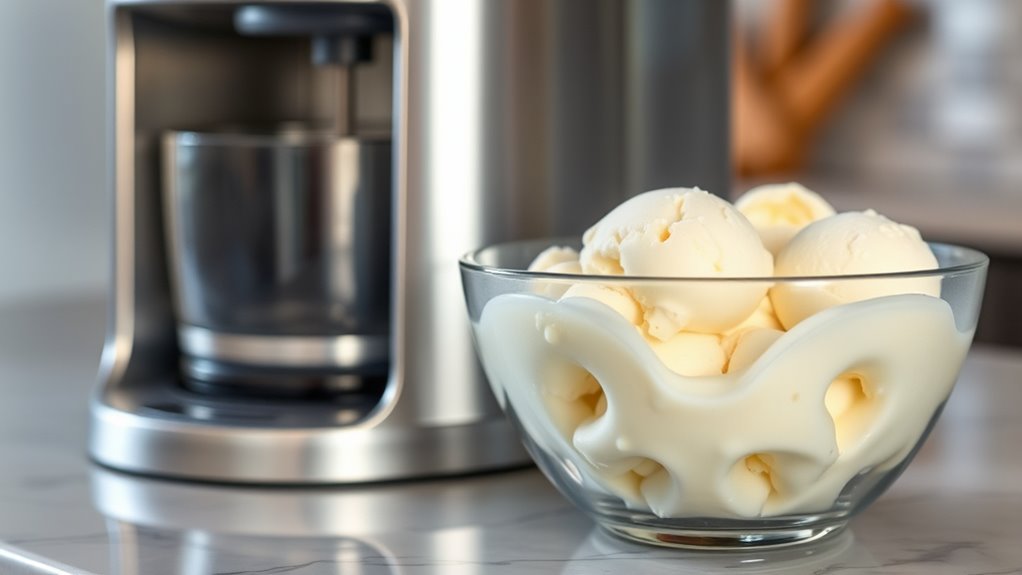
When choosing between freezer bowls and built-in freezing mechanisms, your decision impacts how quickly and conveniently you can make ice cream. Freezer bowls require pre-freezing, which adds some planning but allows for flexible use and easy ingredient customization. They often produce sweet flavor profiles with a rich, fresh taste because you control the ingredients. Additionally, freezing capacity plays a significant role in how much ice cream you can make at once and can influence your overall experience. Built-in freezing mechanisms, on the other hand, freeze automatically during operation, offering faster results without pre-planning. This convenience can save time, especially if you want to experiment with different ingredient combinations frequently. However, they tend to be less customizable since you’re limited to the machine’s settings. Your choice depends on whether you prioritize quick convenience or the flexibility to craft unique, flavor-packed ice creams with personalized ingredients. Additionally, rustic decor can enhance the overall aesthetic of your kitchen, making the ice cream-making process feel even more charming and inviting. Choosing the right system also involves considering the maintenance requirements, which vary between models and can influence long-term satisfaction.
The Role of a Paddle or Dasher in Ice Cream Making
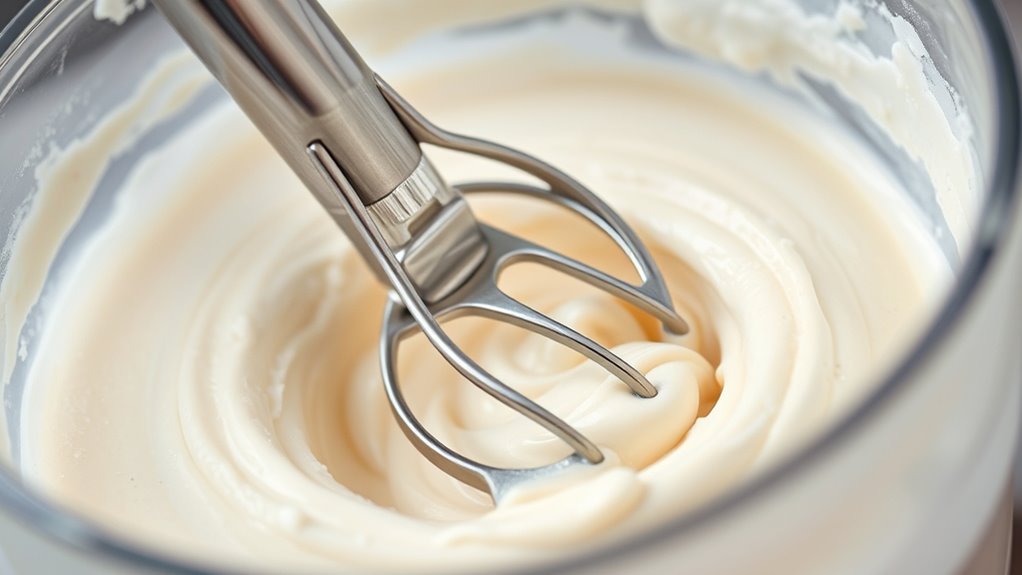
A paddle or dasher plays a crucial role in the ice cream-making process by continuously churning the mixture to incorporate air, prevent ice crystal formation, and achieve the desired creamy texture. The paddle design influences how effectively it mixes, with some models featuring blades optimized for thorough agitation. The dasher function is to evenly distribute ingredients, break up ice crystals, and maintain a smooth consistency. A well-designed paddle ensures the mixture stays aerated and prevents clumping, resulting in a richer, creamier finish. Whether in a manual or electric ice cream maker, the paddle’s shape and rotation speed are key to producing high-quality ice cream. Understanding the paddle or dasher’s role helps you appreciate how it transforms simple ingredients into delicious, velvety frozen treats.
Understanding Capacity: How Much Ice Cream Can It Make?

Knowing your ice cream maker’s capacity helps you plan how much to make for each batch. Check the maximum batch size to avoid overfilling, which can affect quality. Consider your serving goals to decide if the machine’s size fits your needs.
Batch Size Limits
Understanding the capacity of your ice cream maker is essential to make sure you make just the right amount without overloading it. Batch size limits determine how much ice cream you can produce in one cycle, often measured in quarts or liters. Your scoop size affects how many servings you can get from a batch, so choosing the right scoop ensures you don’t exceed capacity. If you want to offer a variety of flavors, keep in mind that larger batches allow for more flavor options in a single run. However, overfilling can strain the machine and affect texture. Always check your maker’s maximum batch size to avoid overflow or poor freezing. Staying within these limits helps you produce quality ice cream efficiently without risking damage to your equipment.
Serving Quantity Goals
To effectively plan your ice cream servings, it’s important to contemplate how much ice cream your machine can produce per batch. Knowing this helps you set realistic portion control and serving size goals. Consider these points:
- Determine the total capacity to avoid overloading your machine.
- Decide on individual serving sizes to match dietary or guest needs.
- Calculate how many servings you can get from each batch for efficient planning.
- Refer to best-selling ice cream makers for popular models with reliable capacity and performance.
- Additionally, understanding the air filtration technologies used in appliances can inform you about the importance of filter maintenance for optimal performance, ensuring your device continues to operate efficiently over time.
- Keep in mind that some essential oils can be used to enhance your experience by adding natural scents or flavors, which might inspire creative ice cream recipes or presentation ideas.
The Significance of Cooling and Freezing Times
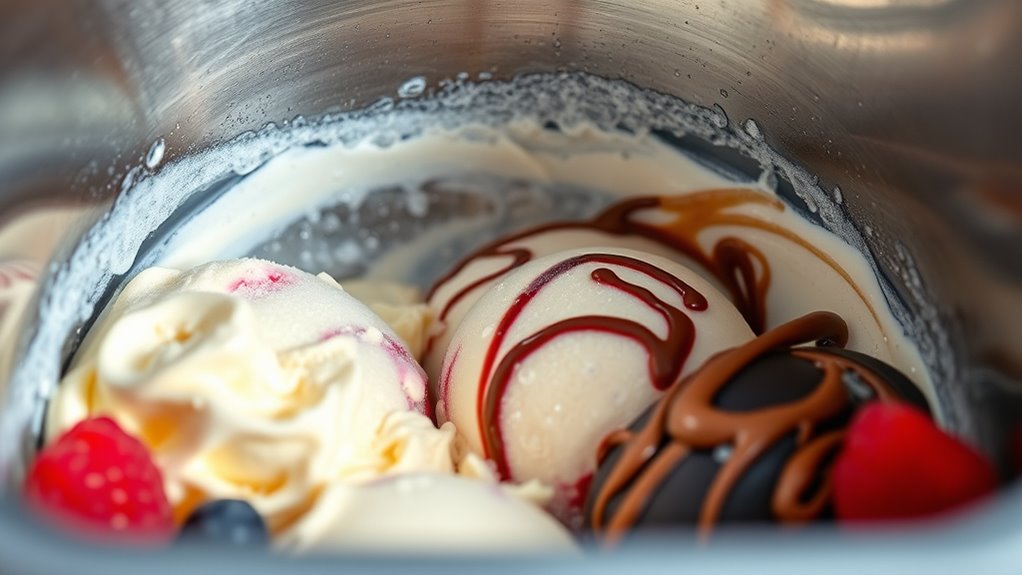
You need to pay attention to chilling and freezing times to get the best results. The duration affects the ice cream’s texture and how smooth it turns out. Variations in freezing time can make a big difference in your final treat. Additionally, understanding keto diet plans can help ensure that your appliance operates reliably and securely. Properly managing storage durations of ingredients like lemon or pineapple juice is also essential for maintaining freshness and quality, especially when selecting the appropriate air purification technology for your environment. Incorporating optimal cookie management practices can also improve your browsing experience and ensure smooth operation of your online resources.
Importance of Chilling Duration
The duration of chilling and freezing times plays a crucial role in achieving the perfect ice cream texture. Proper chilling ensures your mixture reaches the ideal consistency and enhances flavor development. It also influences storage options, keeping your ice cream fresh longer. To maximize results, consider these key points:
- Time for excellent texture – Longer chilling allows ingredients to meld, resulting in a creamier ice cream.
- Flavor enhancement – Adequate chilling releases and intensifies flavors, giving you a richer taste.
- Storage readiness – Properly chilled mixture freezes evenly, reducing ice crystal formation and improving overall quality.
- Efficient cooling can be achieved by using appropriately rated smart appliances, ensuring optimal chilling durations. Additionally, the chilling process is essential for controlling the final ice cream consistency and preventing unwanted ice crystal formation. Incorporating climate control technology can further optimize the temperature regulation during chilling, leading to better results.
Freezing Time Variability
Once your mixture has been properly chilled, the duration of freezing time directly impacts the final ice cream quality. If you freeze it too quickly, the texture may become icy and less smooth, compromising the overall consistency. On the other hand, longer freezing times allow the mixture to solidify more evenly, resulting in a creamier texture and better texture consistency. Additionally, your freezing duration influences flavor infusion; extended freezing helps flavors meld more thoroughly, enhancing the overall taste. Shorter freezing times may leave flavors less integrated, making the ice cream taste more muted. Consequently, adjusting freezing times carefully ensures your ice cream achieves the perfect balance of smoothness and flavor richness, giving you a superior dessert every time.
Impact on Texture
Cooling and freezing times play a pivotal role in shaping the texture of your ice cream. Proper timing influences the texture consistency and the creaminess level you achieve. If you don’t freeze it long enough, your ice cream remains soft and less smooth. Conversely, over-freezing can make it icy and hard. To optimize texture:
- Ensure adequate chilling to develop a smooth, even consistency.
- Allow enough freezing time for the mixture to firm up without becoming brittle.
- Find the sweet spot where the creaminess is maximized, and ice crystals are minimized.
Getting these timings right means your ice cream will have a luscious, velvety texture, and the creaminess level will be just right. Proper cooling and freezing are key to delivering a premium dessert experience.
Additional Features and Accessories to Consider
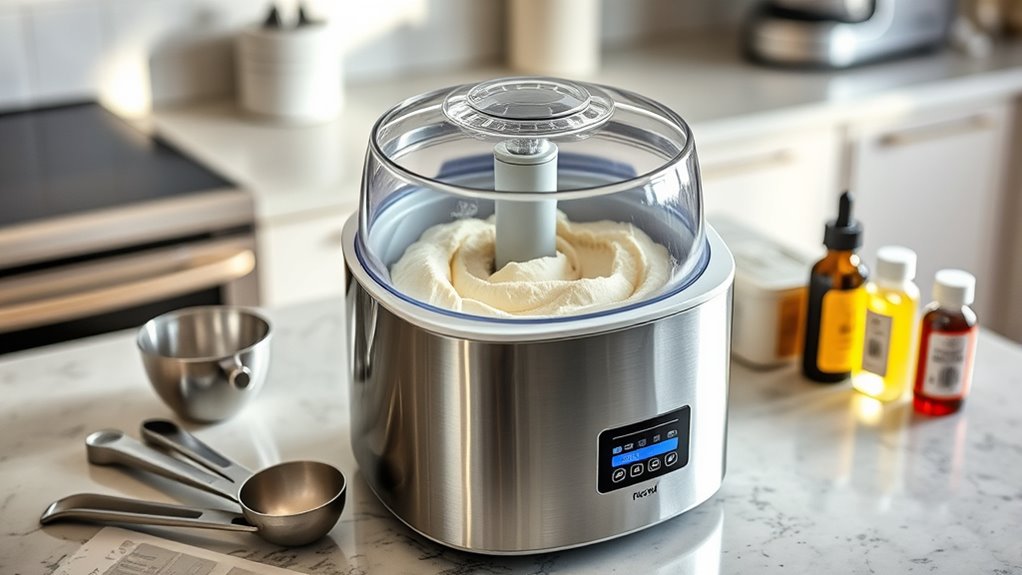
To get the most out of your ice cream maker, consider exploring additional features and accessories that can enhance your experience. For instance, some models include specialized paddles or bowls designed specifically for making gelato vs. sorbet, helping you achieve authentic textures. If you’re interested in vegan alternatives, look for attachments or recipes tailored for dairy-free ingredients like coconut milk or cashew cream. These accessories allow you to experiment with flavors and dietary needs, expanding your options beyond traditional recipes. Additional features like timers, automatic shut-off, or cooling baskets can streamline your process. By choosing the right accessories, you’ll enjoy a wider variety of frozen treats and ensure your ice cream maker adapts to your culinary preferences.
Frequently Asked Questions
Can I Make Sorbet or Frozen Yogurt With an Ice Cream Maker?
Yes, you can make fruit sorbets and dairy-free options with your ice cream maker. Just prepare your fruit puree or juice, sweeten it as needed, and churn it in your machine. Frozen yogurt is also easy—simply mix yogurt with your favorite flavors and freeze. Your ice cream maker handles both, giving you fresh, homemade treats like fruit sorbets and dairy-free options whenever you crave them.
How Long Does It Typically Take to Make Ice Cream?
Making ice cream usually takes about 20 to 40 minutes, depending on your ice cream base. If you’re using a custard base, it might need extra chilling before churning, which can extend the process. Non-custard bases like sorbet typically churn faster. You’ll notice your ice cream thickening and reaching the right consistency during this time. Keep an eye on the texture, and you’ll have delicious homemade ice cream in no time.
Is It Necessary to Pre-Freeze the Bowl Every Time?
Ever wondered if you need to pre-freeze the bowl every time? For the best results, you do need to meet the freezing requirements for your ice cream maker’s bowl preparation. Most models require you to freeze the bowl for at least 12 hours beforehand, but some newer ones have built-in refrigeration. Always check your user manual to verify proper freezing requirements, and you’ll enjoy smooth, creamy ice cream every time.
What’S the Difference Between Churn Rate and Capacity?
Churn rate and capacity differ mainly in how they affect your ice cream making. Churn rate measures how quickly your machine can turn a batch into smooth ice cream, while capacity refers to the maximum batch size it can handle at once. During the freezing process, understanding this helps you plan your batches, ensuring you don’t overload the machine and get the best texture.
Are There Health Benefits to Homemade Ice Cream?
Did you know homemade ice cream can be healthier? When you make it yourself, you control the ingredients, reducing added sugars and choosing dairy alternatives like almond or coconut milk. This can lower your intake of common allergens and saturated fats. Plus, you get the satisfaction of customizing flavors with fresh fruits or natural sweeteners, making it a more nutritious treat compared to store-bought options.
Conclusion
Now that you’re familiar with ice cream maker terms, choosing the right machine becomes a breeze—no need to be a tech whiz or rely on a crystal ball. Whether you prefer a manual or automatic model, understanding these basics helps you craft perfect frozen treats every time. Think of it like having your own culinary time machine, whisking you back to simpler days of homemade delight. So go ahead, get churning and enjoy your sweet victory!






